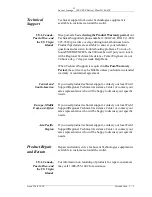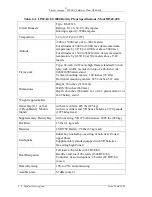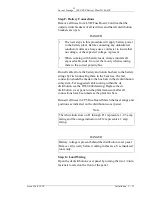
Lucent Lineage
®
2000 ECS Battery Plant H569-408
Issue 2 July 1996
Product Description 2 - 13
When the battery voltage drops below a preset level, a
comparator circuit on the CP5 Fuse Board senses the low voltage
condition and removes power to the contactor. This opens the
connection between Battery Buses 1 and 2, disconnecting the
batteries from the rectifiers and the load. The user has a choice
of disconnect threshold voltages (40.5 and 42.5 volts), as
described in Section 3 of this manual.
When the contactor is open and the rectifiers are not delivering
power, the controller is unpowered as well. In this state, the
controller displays and LEDs are extinguished and various
alarms are issued to the alarm reporting center. (See the
LINEAGE® 2000 Controller manual for further details.)
Red “LVD OPEN” and yellow “LVD FAIL” LEDs are located
on the dc distribution panel. The red “LVD OPEN” LED is lit
whenever the contactor is open, during a normal disconnect or in
the unlikely event of a contactor failure. The LVD sensing
circuitry is redundant. A failure of either voltage detector circuit
lights the yellow “LVD FAIL” LED, but the contactor will stay
closed. A Fuse Alarm Minor (MNF) is issued when a LVD
circuit fails, lighting a yellow LED on the controller front panel
and sending Power Minor (PMN) alarms to the alarm reporting
center.
Circuit Breakers
The standard dc distribution panel (see Figure 2-5) can
accommodate a maximum of 42 circuit breakers. The circuit
breakers are plug-in style, KS-23616, and are available in 10, 20,
30, 45 and 60 ampere ratings. These breakers have standard
curve 2 trip characteristics and an interrupt capacity of 7000
amperes. The 45 and 60 ampere circuit breakers require the use
of two positions on the panel. A two position load and return bus
adapter terminal is included with the 45 and 60 ampere breakers.
The breakers are mounted vertically with actuators up in the ON
position. Each circuit breaker is equipped with an auxiliary
switch that indicates, with a closure, when the breaker has
tripped due to overcurrent. The circuit breaker handle will move
to a center trip position when tripped due to overcurrent. It
should be noted here that customers who wish to prewire load
circuits for future use may store the breaker in its installed
position until service is actually required. Leaving the breaker in
the OFF position in an operating battery plant will not produce
an alarm condition.
















































